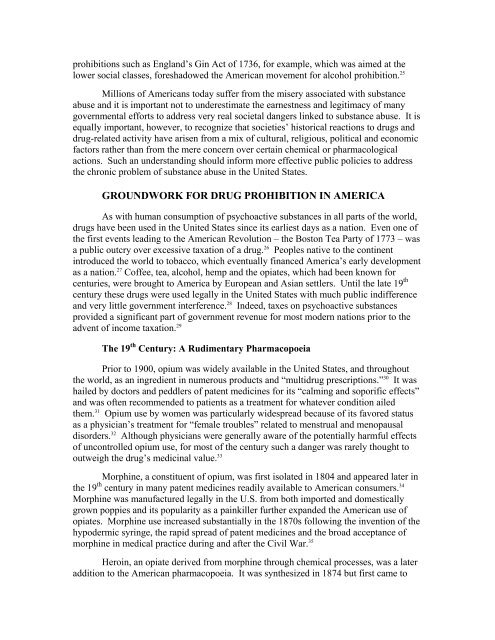Effective Drug Control: Toward A New Legal Framework
Effective Drug Control: Toward A New Legal Framework
Effective Drug Control: Toward A New Legal Framework
Create successful ePaper yourself
Turn your PDF publications into a flip-book with our unique Google optimized e-Paper software.
prohibitions such as England’s Gin Act of 1736, for example, which was aimed at the<br />
lower social classes, foreshadowed the American movement for alcohol prohibition. 25<br />
Millions of Americans today suffer from the misery associated with substance<br />
abuse and it is important not to underestimate the earnestness and legitimacy of many<br />
governmental efforts to address very real societal dangers linked to substance abuse. It is<br />
equally important, however, to recognize that societies’ historical reactions to drugs and<br />
drug-related activity have arisen from a mix of cultural, religious, political and economic<br />
factors rather than from the mere concern over certain chemical or pharmacological<br />
actions. Such an understanding should inform more effective public policies to address<br />
the chronic problem of substance abuse in the United States.<br />
GROUNDWORK FOR DRUG PROHIBITION IN AMERICA<br />
As with human consumption of psychoactive substances in all parts of the world,<br />
drugs have been used in the United States since its earliest days as a nation. Even one of<br />
the first events leading to the American Revolution – the Boston Tea Party of 1773 – was<br />
a public outcry over excessive taxation of a drug. 26 Peoples native to the continent<br />
introduced the world to tobacco, which eventually financed America’s early development<br />
as a nation. 27 Coffee, tea, alcohol, hemp and the opiates, which had been known for<br />
centuries, were brought to America by European and Asian settlers. Until the late 19 th<br />
century these drugs were used legally in the United States with much public indifference<br />
and very little government interference. 28 Indeed, taxes on psychoactive substances<br />
provided a significant part of government revenue for most modern nations prior to the<br />
advent of income taxation. 29<br />
The 19 th Century: A Rudimentary Pharmacopoeia<br />
Prior to 1900, opium was widely available in the United States, and throughout<br />
the world, as an ingredient in numerous products and “multidrug prescriptions.” 30 It was<br />
hailed by doctors and peddlers of patent medicines for its “calming and soporific effects”<br />
and was often recommended to patients as a treatment for whatever condition ailed<br />
them. 31 Opium use by women was particularly widespread because of its favored status<br />
as a physician’s treatment for “female troubles” related to menstrual and menopausal<br />
disorders. 32 Although physicians were generally aware of the potentially harmful effects<br />
of uncontrolled opium use, for most of the century such a danger was rarely thought to<br />
outweigh the drug’s medicinal value. 33<br />
Morphine, a constituent of opium, was first isolated in 1804 and appeared later in<br />
the 19 th century in many patent medicines readily available to American consumers. 34<br />
Morphine was manufactured legally in the U.S. from both imported and domestically<br />
grown poppies and its popularity as a painkiller further expanded the American use of<br />
opiates. Morphine use increased substantially in the 1870s following the invention of the<br />
hypodermic syringe, the rapid spread of patent medicines and the broad acceptance of<br />
morphine in medical practice during and after the Civil War. 35<br />
Heroin, an opiate derived from morphine through chemical processes, was a later<br />
addition to the American pharmacopoeia. It was synthesized in 1874 but first came to
















